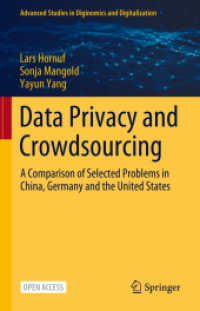Full Description
Educational practice does not, for the most part, rely on research findings. Instead, there's a preference for relying on our intuitions about what's best for learning. But relying on intuition may be a bad idea for teachers and learners alike.
This accessible guide helps teachers to integrate effective, research-backed strategies for learning into their classroom practice. The book explores exactly what constitutes good evidence for effective learning and teaching strategies, how to make evidence-based judgments instead of relying on intuition, and how to apply findings from cognitive psychology directly to the classroom.
Including real-life examples and case studies, FAQs, and a wealth of engaging illustrations to explain complex concepts and emphasize key points, the book is divided into four parts:
Evidence-based education and the science of learning
Basics of human cognitive processes
Strategies for effective learning
Tips for students, teachers, and parents.
Written by "The Learning Scientists" and fully illustrated by Oliver Caviglioli, Understanding How We Learn is a rejuvenating and fresh examination of cognitive psychology's application to education. This is an essential read for all teachers and educational practitioners, designed to convey the concepts of research to the reality of a teacher's classroom.
Contents
Acknowledgments Author Profile Illustrator Profile Part 1 Evidence-Based Education and the Science of Learning Chapter 1: Communication Breakdown Between Science and Practice in Education Chapter 2: Different Types of Evidence in Education Chapter 3: Is Intuition the Enemy of Teaching and Learning? Chapter 4: Pervasive Misunderstandings About Learning: How They Arise, and What We Can Do Part 2 Basics of Human Cognitive Processes Chapter 5: Perception Chapter 6: Attention Chapter 7: Memory Part 3 Strategies for Effective Learning Introduction Chapter 8: Planning Learning: Spaced Practice and Interleaving Chapter 9: Development of Understanding Chapter 10: Reinforcement of Learning: Retrieval Practice Part 4 Tips for Teachers, Students, and Parents Chapter 11: Tips for Teachers Chapter 12: Tips for Students Chapter 13: Tips for Parents Glossary








